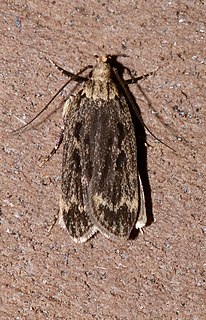Cynicostola is a monotypic genus of moth in the family Lecithoceridae. It contains the species Cynicostola pogonias, which is found in southern India.
Torodora sortilega is a moth in the family Lecithoceridae. It is found in the Khasi Hills of Meghalaya, India, and in Taiwan. The Taiwanese specimens were obtained at elevations of 650–760 m (2,130–2,490 ft) above sea level.
Anacampsis peloptila is a moth of the family Gelechiidae. It was described by Edward Meyrick in 1914. It is found in Guyana.
Carodista geraea is a moth in the family Lecithoceridae. It was described by Edward Meyrick in 1911. It is found in Sri Lanka.
Lecithocera deleastra is a moth in the family Lecithoceridae. It was described by Edward Meyrick in 1911. It is found in Sri Lanka.
Torodora fortis is a moth in the family Lecithoceridae. It was described by Edward Meyrick in 1918. It is found in southern India.
Torodora carcerata is a moth in the family Lecithoceridae. It was described by Edward Meyrick in 1923. It is found in Assam, India.
Torodora opportuna is a moth in the family Lecithoceridae. It was described by Edward Meyrick in 1923. It is found in Assam, India.
Torodora eupatris is a moth in the family Lecithoceridae. It was described by Edward Meyrick in 1910. It is found in Assam, India.
Torodora oxalea is a moth in the family Lecithoceridae. It was described by Edward Meyrick in 1910. It is found in southern India.
Torodora claustrata is a moth in the family Lecithoceridae. It was described by Edward Meyrick in 1910. It is found on Borneo.
Deltoplastis straminicornis is a moth in the family Lecithoceridae. It was described by Edward Meyrick in 1910. It is found in Sri Lanka.

Martyringa xeraula, the Himalayan grain moth, is a moth in the family Lecithoceridae. It was described by Edward Meyrick in 1910. It is found in India (Assam), western China, Japan and North America, where it has been recorded from Louisiana, Texas and from Florida to South Carolina.
Torodora bracculata is a moth in the family Lecithoceridae. It was described by Edward Meyrick in 1911. It is found in Assam, India.
Torodora deltospila is a moth in the family Lecithoceridae. It was described by Edward Meyrick in 1911. It is found in India in Assam, Himachal Pradesh, Dehradun and Jammu and Kashmir.
Torodora pellax is a moth in the family Lecithoceridae. It was described by Edward Meyrick in 1911. It is found in Assam, India.
Torodora thraneuta is a moth in the family Lecithoceridae. It was described by Edward Meyrick in 1911. It is found in Sri Lanka.
Torodora arcifera is a moth in the family Lecithoceridae. It was described by Edward Meyrick in 1907. It is found in Bhutan.
Torodora parasema is a moth in the family Lecithoceridae. It was described by Edward Meyrick in 1913. It is found in India.
Torodora syrphetodes is a moth in the family Lecithoceridae. It was described by Edward Meyrick in 1906. It is found in Sri Lanka.
